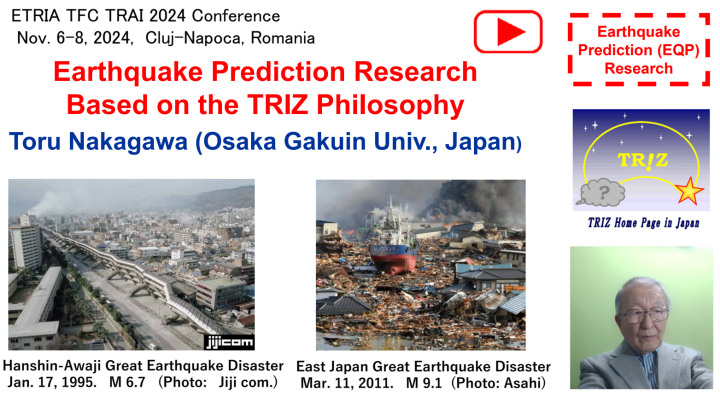Editor's Note (Toru Nakagawa, Feb. 19, 2025)
Earthquake Prediction Research Based on the TRIZ Philosophy: (6) Paper, Slides, and Video Presented at the ETRIA TRAI 2024 (Nov. 6-8, Romania)

[Click the figure to enlarge further.]
Today is the 30th memorial day of the 1995 Hanshin-Awaji Great Earthquake Disaster. More than 6,800 people died under the collapsed houses/buildings and the following big fires. The main highway from Osaka to Kobe collapsed (see the photo below left). This happened near my hometown where I lived during my school days. ...
In this LinkedIn article, I introduce you to my presentation at the ETRIA TRAI 2024 conference, held on Nov. 6-8, 2024 at Cluj-Napoca, Romania. I submitted the final paper on Aug. 12, but was unable to travel to Romania due to my health condition. Thanks to the kind arrangement of the conference organizers, I made a video presentation at the session.
On Nov. 26, I posted the complete documents on my website "TRIZ Home Page in Japan": they include the paper (18 pages), the presentation slides (10 slides), and the presentation video (.mp4, 16 minutes). Click here to start the video.
My series of LinkedIn articles more or less cover the first parts of my ETRIA paper:
(1) Why and How I Decided to Work on this Difficult Topic
(2) Requirements of Precursors for Short-term EQ Prediction
(3) For Selecting "Promising Precursor Phenomena"
(4) Tsutsui Method: Observing Underground DC Electric Field
(5) Kamiyama Method: Observing Crustal Strains using GNSS Data
Based on these findings, I propose five stages of Earthquake Prediction Research. They are:
Stage (0) Search for various candidates of precursor phenomena; Try and develop observation methods/instruments.
Stage (1) Observe a candidate phenomenon at a single site; Develop the observation method/instrument; Examine the correlation with (some types of) EQs.
Stage (2) Form a research project by multiple groups/sites; Observe the phenomenon at multiple sites in parallel; Confirm the correlation with (some types of) EQs.
Stage (3) Country-wide network of observation sites and groups; Observe and analyze many cases of EQs, and try to predict EQs; Establish a method to predict EQs (where, when, how large).
Stage (4) Integrate different complementary methods for EQ prediction; Construct a technical system of analyzing/predicting EQs; Demonstrate the usefulness of predicting damaging EQs.
Stage (5) Get the understanding by academia, society, and government; Official operation of warning system of EQ prediction; Practice and improve it further; Deploy the system in the world.
After a long period of EQP research in the dark at Stage (0), at least two methods in Japan (Kamiyama method and Tsutsui method) have passed the Stage (1) and will now enter the Stage (2).
Therefore, I propose to form a collaborative research project within EPSJ (Earthquake Prediction Society of Japan) for several groups to observe the phenomena in parallel.
Assuming that 5 years are necessary at each Stage, we have a vision of official/social operation of the warning system of EQ prediction hopefully in 20 years.
----
PS: At EPSJ Conference on Dec. 21-22, I gave a presentation on this topic in a clearer form. The full document is posted on my website in Japanese. I will post it in English in
